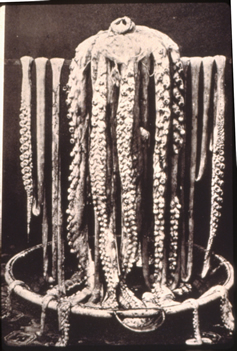| About the Exhibit
Based on the popular permanent exhibition at the Smithsonian's National Museum of Natural History, In Search of Giant Squid features a rare giant squid beak and suckers and examines the myths and legends that surround giant squid. Compare the giant squid with other squids and mollusks, and explore what is known about how they hunt, move, and defend themselves. Learn about scientists' research on their anatomy and behavior. Interactive components allow visitors to compare their own size to a giant squid and experience the giant squid's presumed environment. Nautilus fossils and ammonites from the Burke Museum’s own permanent collection will supplement the exhibit. This exhibition comes to the Burke during an exciting time for researchers of these enormous marine animals. Scientists are just beginning to unlock some of the secrets of the giant squid’s natural history. In December 2006, researchers in Japan captured on film the elusive giant squid, live and in the wild, for the first time ever. Prior to this, giant squid could only be studied when their bodies washed ashore, became entangled in a fisherman’s net, or were found in the bellies of sperm whales. With recent photographs and video footage of the animals, the opportunities for researchers to decipher these mysterious creatures have expanded greatly. Measuring up to 60 feet, it is no surprise that the giant squid has long been depicted in literature and popular culture as a “sea monster.” From descriptions of the animal in ancient mythology to modern Hollywood renditions, the giant squid is usually viewed as a mystical, enigmatic, malevolent beast of the sea. While these depictions may be exaggerated, it is true that giant squid are still relatively mysterious animals. What is known is that giant squid live at depths of 650 to 2,600 feet below the ocean’s surface, they have the world’s largest eyes, and their only predator is the sperm whale. There is little known about how giant squid live, breed, and hunt, but answers to many of these questions may not be far off. |

First complete giant squid found in 1874. |

